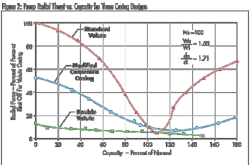The City of Chandler, Arizona, recently completed a migration of its automated control systems. The project replaced aging Modicon 984 Compact brand PLCs with modern Modicon M340 hardware from Schneider Electric. The new processor uses a non-volatile memory and does not require a backup battery. One advantage of the M340 PLC was a similar footprint to the 984 Compact. This meant that existing panels needed minimal modifications.
By Grant Van Hemert
According to their website, Chandler Arizona is a “modern mix of youthfulness and tradition.” This mix has been enacted within the city’s Water System facilities.
Source waters for Chandler’s water production and treatment system are as convoluted as the history of the southwest, and represents Arizona’s struggle to obtain enough water to support its growth. Where many cities have one water source, Chandler has no less than 29. There are 27 ground water wells throughout the city, including six leased from the Salt River Project (SRP). There are two surface water sources, Central Arizona Project (CAP), and SRP. Up to 12 mgd of CAP water is treated by the San Tan Vista Water Treatment facility, jointly owned with Town of Gilbert. Up to 60 mgd of SRP is treated by the Water Treatment Plant in Chandler. To make things more complicated, CAP and SRP both receive water from multiple sources.
What is easier to grasp is that the city delivers an annual average of 54 mgd, with summer daily peak of 75 mgd, to customers. Surface water from the two plants delivers most of the water, with ground water supplementing the diurnal peaking cycles.
Over time the control system for water production evolved into a DCS based SCADA managed from Chandler’s control room. This SCADA communicated via radio to various remote well/reservoir/booster stations. The control systems at these remote stations used a collection of programmable logic controllers (PLC) from different manufacturers. As the city staff gained experience with these systems, they migrated from multiple suppliers to Schneider Electric’s Modicon 984 Compact brand PLC. These 984 Compact PLCs worked well for many years.
Migration Decisions
As years passed, and technology advanced, Schneider Electric realized that the 984 Compact PLC was no longer state of the art.
“With the planned obsolescence of the 984 Compact we decided that it was time to examine what our options were for these units,” said John Ardans, Chandler’s Water Systems Maintenance Superintendent.
Chandler examined several options and manufacturers. The city decided to choose a new controller from Schneider Electric. One of the leading factors was the comfort level with the Modicon PLCs and the support that Chandler received from their long term automation distributor Summit Electric Supply.
Chandler then examined two different platforms; the Modicon Momentum PLC and the Modicon M340. At the time of the comparison, the Modicon Momentum had several advantages. The main advantage with the Momentum was the ability to use the ladder logic that the 984 Compact used. This would save in programming development costs. If the comparison was done today, both the Modicon Momentum and the M340 could reuse programs.
One advantage of the M340 PLC was a similar footprint to the 984 Compact. This meant that the panels needed minimal modifications. The city decided that the additional power of the M340, and the cost savings on panel construction, offset the desire to reuse the logic.
“We could have converted the 984 Compact’s program to a M340 equivalent. However, we wanted to utilize some of the advanced features the Unity programming software could provide,” Ardans said. “Thus we decided to redevelop the program.”
The M340 hardware presented three other benefits for the City of Chandler. First, the processor uses a non-volatile memory for the PLC’s program. This means that the processor does not have a backup battery. These batteries are heat sensitive. By selecting a processor without a battery, the PLC is more suitable for Chandler’s high heat dessert environment.
Additionally, it uses a standard USB to mini D-shell cable for programming. This non-proprietary cable can be purchased at many retail outlets. Thus, if a cable is damaged, the programmer can secure a replacement quickly from a store near the station that is being maintained. This can improve service time.
Finally, the processor has the ability to store cut sheets, users’ manuals, drawings, and other documents in the PLC. Thus, each station no longer needs drawings or manuals that can be damaged or lost.
To help with the installation and development, the city hired the services of Jens Jensen from Jensen Systems Inc. Jensen Systems has a 20 year partnership with the city and the company had installed many of the 984 systems that were being replaced.
The city and Jensen Systems tackled the migration in three steps: Hardware considerations, software considerations, and operational considerations. All three occurred simultaneously.
The new M340 PLCs had a similar footprint to the 984 Compact. This meant that the panels needed minimal modifications.
Hardware Considerations
The migration impacted over 70 remote stations. These included well facilities with arsenic treatment, well facilities without treatment, reservoir booster facilities, low pressure stations to residential neighborhoods, wastewater lift stations, water pump stations, and pressure reducing stations.
The large variety of stations, and their critical nature, introduced two challenges for Jensen Systems. The first challenge was a cost effective and rapid method to redesign the installed panels. Since the PLC was the only change, then the only consideration was any changes in Input or Output (I/O) layout, and what M340 configuration could fit in the available space.
“Some of the stations had been modified over the years, or were being modified as part of this project. This meant that I/O had to be added, deleted, or relocated for organizational purposes,” Jensen said. “To do this we developed a set of drawings that allows us to correlate the 984 Compact wiring with the M340 wiring.”
With the 984 Compact to M340 correlation table, and the wiring diagrams, parts could be ordered and work could proceed without an in-depth analysis of the station to be worked on. These tools allowed for each station to be converted rapidly. Also, this decreased the total anticipated project time.
The second challenge involved streamlining the software conversion. Many of these stations were critical to the infrastructures operation. Some stations could be operated in manual, but manual mode comes at the sacrifice of optimum performance. Thus, conversion had to be conducted very quickly.
Software Considerations
Chandler’s retrofit project was somewhat unique. In most remote application projects, the task is to install, or retrofit, a single station. These projects tend to be focused on the station instead of the whole system. This retrofit provided the opportunity to look at the entire system, discover what worked best from a system wide standpoint, and optimize each station accordingly.
The system wide approach provided the ability to streamline programs. Chandler wanted the following:
- A unified and flexible program that could be applied at all the stations.
- A program that was easy to understand, troubleshoot, and modify.
- A program that had all documentation stored in the processor, so that the master program was not needed to see documentation.
- A program that could be given to all of the maintenance teams so that they could use it as needed.
To accomplish this, Jensen Systems and the city of Chandler decided to use the Function Block programming language within the Unity programming software. Function blocks take sections of code and encapsulate it into a single instruction. This makes it much easier to understand the assembled code.
For example, a two pump VFD system program may consist of several dozen ladder logic rungs. These rungs might include start/stop, speed modulation, lead/lag changeover, instrument scaling, alarm generation, and safety interlocking functions. During troubleshooting, you may need to scroll, or switch between multiple windows to understand the interrelated nature of the operation. In a function block oriented program, there would be a separate block for each function. Thus, start/stop would have its own block, speed modulation would be a separate block, and so on. Since each function has its own dedicated instruction, the amount of viewable code is reduced. This means that identifying an anomaly occurs rapidly. Then the blocks code can be examined to see what the cause is.
“As we installed stations, we learned more about the system as a whole,” Jensen said. “This meant we had to revisit stations to make sure the programs were still unified. This was an anticipated activity. The choice of Function block programming made this updating easier because we usually had to replace only one block instead of multiple lines of ladder logic.”
The SCADA migration impacted over 70 remote stations, including reservoir booster facilities and pump stations.
To make the program easy to troubleshoot, text descriptions were added liberally. The M340 stores documentation in the processor. Other PLCs store the documentation on a computer; this means that an exact copy of the program has to be on the technician’s computer to see the documentation. This type of computer based documentation presents a problem for Chandler’s mobile maintenance staff: finding the time to update everyone’s programs on a regular basis is very difficult.
Variables were given descriptive names instead of names based on instrument symbology standards. This was done for two reasons. First, the documentation and variable names are stored in the processor. This means that the names are only local to the station that is being examined. The second reason is that instrument symbology names are typically used to uniquely identify equipment within a facility. This would mean that each station would have a unique series number. Using a variable identifier based on this would not allow the program to be universally applied.
Operation Considerations
As the project progressed, it became obvious that all 70 stations could not be migrated at one time. Thus, individual stations were either manually operated or taken off line while the conversion occurred. To minimize disruption to the city, as much work as possible was done ahead of time. The tools described above contributed significantly to this goal. For an average station, Jensen Systems took a day to prepare the hardware and configure the standard program for site specific conditions. A second day was used in testing, and finally a third day was used in changing over the wiring.
Since the programming software, programming language, and program was different then what was in the 984 Compacts, training had to take place. This training occurred in two parts. The first was classroom training on the Unity Programming Software, and this took place at Summit Electric Supply. The second part occurred during system implementation. Individuals with the city assisted and observed Jensen Systems and learned during various station start ups.
Another aspect of operations this conversion improved was in regards to manual operation at some of the stations. Originally all of the booster stations were operated manually from SCADA. This meant the city had to rapidly react to changes to prevent the risk of pipe bursts. All of the booster stations now have the capability of operating with minimal SCADA interaction. This reduces staff stress, and increases response time to pumping changes.
Realized Benefits
With the migration complete, Chandler, AZ, is experiencing the benefits of this project. First off, there is a single hardware platform for ease of hardware troubleshooting. Furthermore, the PLC programs have been reduced from over 70 dedicated programs to one.
From a hardware standpoint, the absence of a backup battery, and the use of a standard programming cable helps increase reliability. Additionally, the ability to store documents in the processor reduces the possibility of losing or damaging drawings for the station.
The project path streamlined program conversion and installation. This minimized disruptions for the city and its staff. Finally, converting the booster stations has reduced the possibility of pipe bursts.
WW
About the Author: Grant Van Hemert, P.E., is a water wastewater applications specialist for the Schneider Electric Water and Wastewater Competency Center. He has 16 years experience in water and wastewater automation, and another five years in automation and control engineering. He is a registered P.E. in the state of North Carolina and is a past chairperson for the AWWA Instrumentation and Control Committee. Van Hemert can be reached at [email protected].
More WaterWorld Current Issue Articles
More WaterWorld Archives Issue Articles




